Sustainable Mobility Scooter: Research on Environmentally Sustainable Electric Mobility
VerifiedAdded on 2023/06/11
|17
|4473
|375
AI Summary
This research paper focuses on designing an environmentally sustainable electric mobility scooter through recycling, reuse, and replacement of its components. It evaluates the functional groups and components of the proposed mobility scooter and proposes waste management strategies for a more sustainable and effective management of waste.
Contribute Materials
Your contribution can guide someone’s learning journey. Share your
documents today.
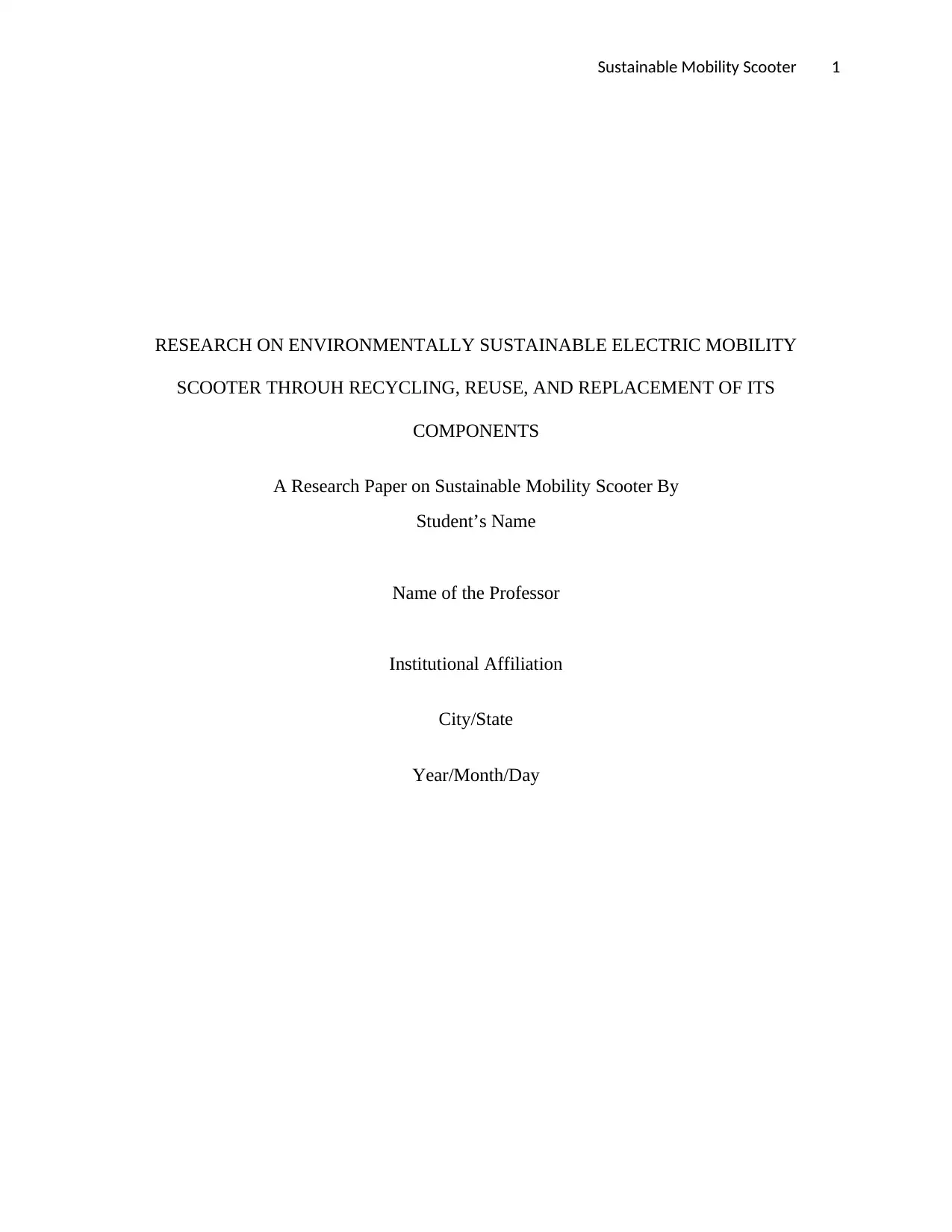
Sustainable Mobility Scooter 1
RESEARCH ON ENVIRONMENTALLY SUSTAINABLE ELECTRIC MOBILITY
SCOOTER THROUH RECYCLING, REUSE, AND REPLACEMENT OF ITS
COMPONENTS
A Research Paper on Sustainable Mobility Scooter By
Student’s Name
Name of the Professor
Institutional Affiliation
City/State
Year/Month/Day
RESEARCH ON ENVIRONMENTALLY SUSTAINABLE ELECTRIC MOBILITY
SCOOTER THROUH RECYCLING, REUSE, AND REPLACEMENT OF ITS
COMPONENTS
A Research Paper on Sustainable Mobility Scooter By
Student’s Name
Name of the Professor
Institutional Affiliation
City/State
Year/Month/Day
Secure Best Marks with AI Grader
Need help grading? Try our AI Grader for instant feedback on your assignments.
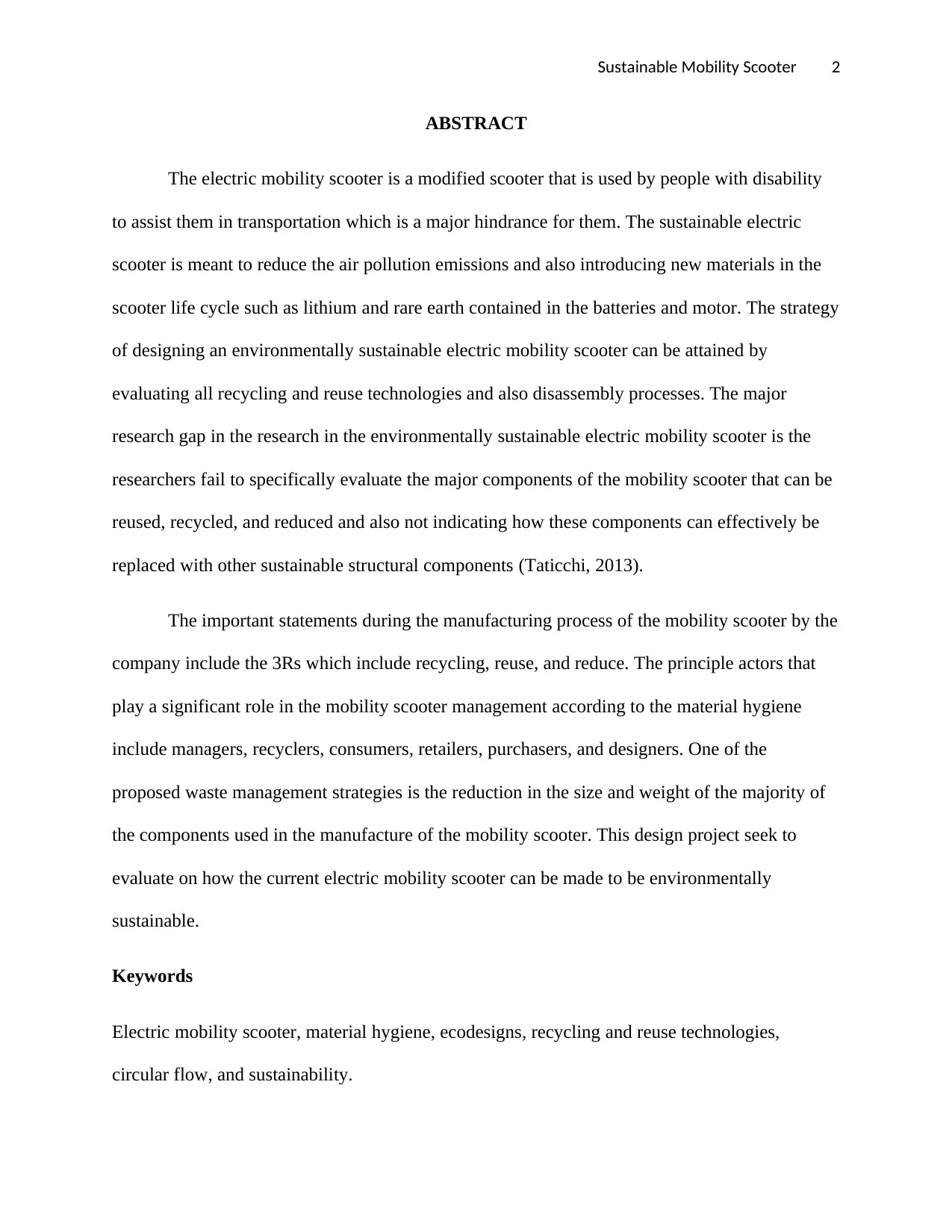
Sustainable Mobility Scooter 2
ABSTRACT
The electric mobility scooter is a modified scooter that is used by people with disability
to assist them in transportation which is a major hindrance for them. The sustainable electric
scooter is meant to reduce the air pollution emissions and also introducing new materials in the
scooter life cycle such as lithium and rare earth contained in the batteries and motor. The strategy
of designing an environmentally sustainable electric mobility scooter can be attained by
evaluating all recycling and reuse technologies and also disassembly processes. The major
research gap in the research in the environmentally sustainable electric mobility scooter is the
researchers fail to specifically evaluate the major components of the mobility scooter that can be
reused, recycled, and reduced and also not indicating how these components can effectively be
replaced with other sustainable structural components (Taticchi, 2013).
The important statements during the manufacturing process of the mobility scooter by the
company include the 3Rs which include recycling, reuse, and reduce. The principle actors that
play a significant role in the mobility scooter management according to the material hygiene
include managers, recyclers, consumers, retailers, purchasers, and designers. One of the
proposed waste management strategies is the reduction in the size and weight of the majority of
the components used in the manufacture of the mobility scooter. This design project seek to
evaluate on how the current electric mobility scooter can be made to be environmentally
sustainable.
Keywords
Electric mobility scooter, material hygiene, ecodesigns, recycling and reuse technologies,
circular flow, and sustainability.
ABSTRACT
The electric mobility scooter is a modified scooter that is used by people with disability
to assist them in transportation which is a major hindrance for them. The sustainable electric
scooter is meant to reduce the air pollution emissions and also introducing new materials in the
scooter life cycle such as lithium and rare earth contained in the batteries and motor. The strategy
of designing an environmentally sustainable electric mobility scooter can be attained by
evaluating all recycling and reuse technologies and also disassembly processes. The major
research gap in the research in the environmentally sustainable electric mobility scooter is the
researchers fail to specifically evaluate the major components of the mobility scooter that can be
reused, recycled, and reduced and also not indicating how these components can effectively be
replaced with other sustainable structural components (Taticchi, 2013).
The important statements during the manufacturing process of the mobility scooter by the
company include the 3Rs which include recycling, reuse, and reduce. The principle actors that
play a significant role in the mobility scooter management according to the material hygiene
include managers, recyclers, consumers, retailers, purchasers, and designers. One of the
proposed waste management strategies is the reduction in the size and weight of the majority of
the components used in the manufacture of the mobility scooter. This design project seek to
evaluate on how the current electric mobility scooter can be made to be environmentally
sustainable.
Keywords
Electric mobility scooter, material hygiene, ecodesigns, recycling and reuse technologies,
circular flow, and sustainability.
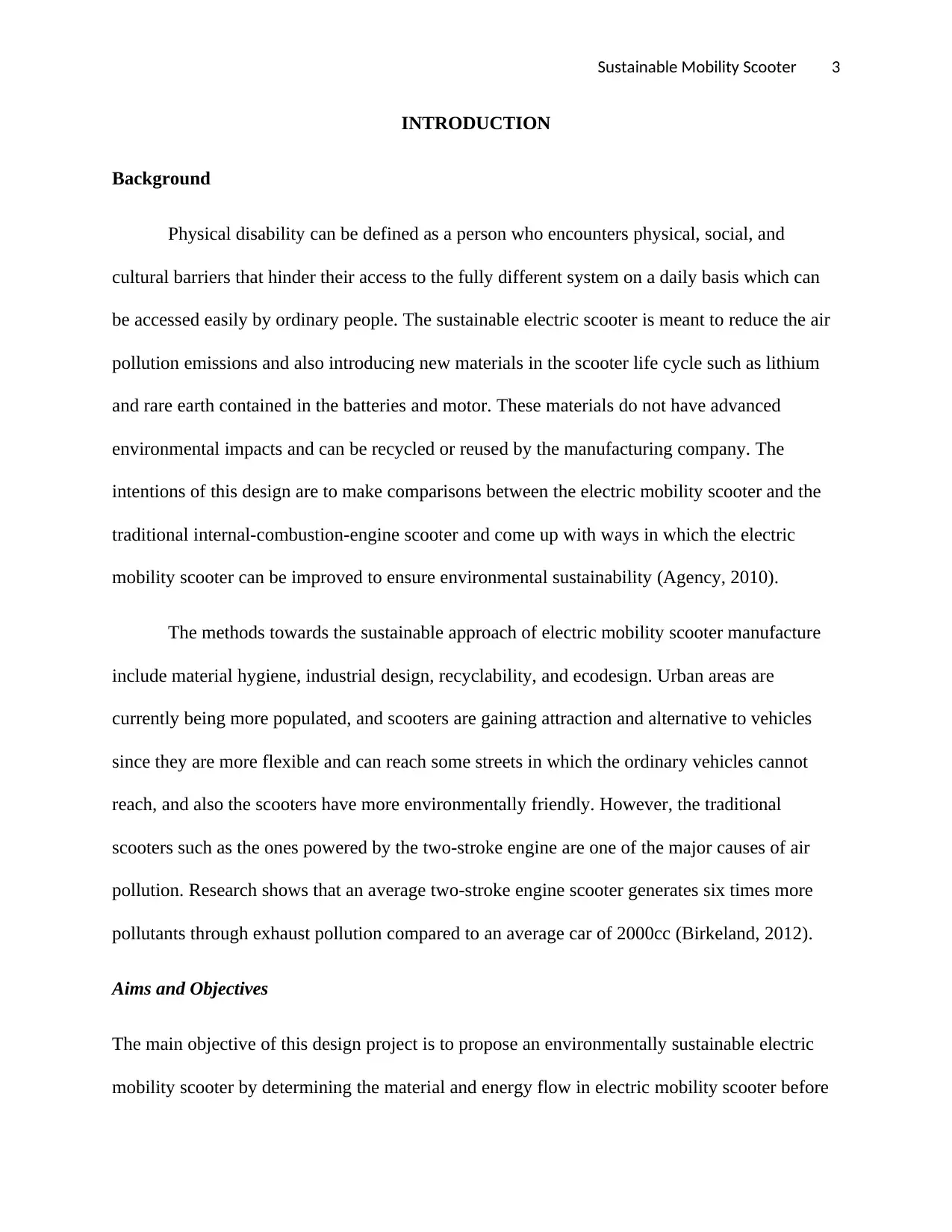
Sustainable Mobility Scooter 3
INTRODUCTION
Background
Physical disability can be defined as a person who encounters physical, social, and
cultural barriers that hinder their access to the fully different system on a daily basis which can
be accessed easily by ordinary people. The sustainable electric scooter is meant to reduce the air
pollution emissions and also introducing new materials in the scooter life cycle such as lithium
and rare earth contained in the batteries and motor. These materials do not have advanced
environmental impacts and can be recycled or reused by the manufacturing company. The
intentions of this design are to make comparisons between the electric mobility scooter and the
traditional internal-combustion-engine scooter and come up with ways in which the electric
mobility scooter can be improved to ensure environmental sustainability (Agency, 2010).
The methods towards the sustainable approach of electric mobility scooter manufacture
include material hygiene, industrial design, recyclability, and ecodesign. Urban areas are
currently being more populated, and scooters are gaining attraction and alternative to vehicles
since they are more flexible and can reach some streets in which the ordinary vehicles cannot
reach, and also the scooters have more environmentally friendly. However, the traditional
scooters such as the ones powered by the two-stroke engine are one of the major causes of air
pollution. Research shows that an average two-stroke engine scooter generates six times more
pollutants through exhaust pollution compared to an average car of 2000cc (Birkeland, 2012).
Aims and Objectives
The main objective of this design project is to propose an environmentally sustainable electric
mobility scooter by determining the material and energy flow in electric mobility scooter before
INTRODUCTION
Background
Physical disability can be defined as a person who encounters physical, social, and
cultural barriers that hinder their access to the fully different system on a daily basis which can
be accessed easily by ordinary people. The sustainable electric scooter is meant to reduce the air
pollution emissions and also introducing new materials in the scooter life cycle such as lithium
and rare earth contained in the batteries and motor. These materials do not have advanced
environmental impacts and can be recycled or reused by the manufacturing company. The
intentions of this design are to make comparisons between the electric mobility scooter and the
traditional internal-combustion-engine scooter and come up with ways in which the electric
mobility scooter can be improved to ensure environmental sustainability (Agency, 2010).
The methods towards the sustainable approach of electric mobility scooter manufacture
include material hygiene, industrial design, recyclability, and ecodesign. Urban areas are
currently being more populated, and scooters are gaining attraction and alternative to vehicles
since they are more flexible and can reach some streets in which the ordinary vehicles cannot
reach, and also the scooters have more environmentally friendly. However, the traditional
scooters such as the ones powered by the two-stroke engine are one of the major causes of air
pollution. Research shows that an average two-stroke engine scooter generates six times more
pollutants through exhaust pollution compared to an average car of 2000cc (Birkeland, 2012).
Aims and Objectives
The main objective of this design project is to propose an environmentally sustainable electric
mobility scooter by determining the material and energy flow in electric mobility scooter before
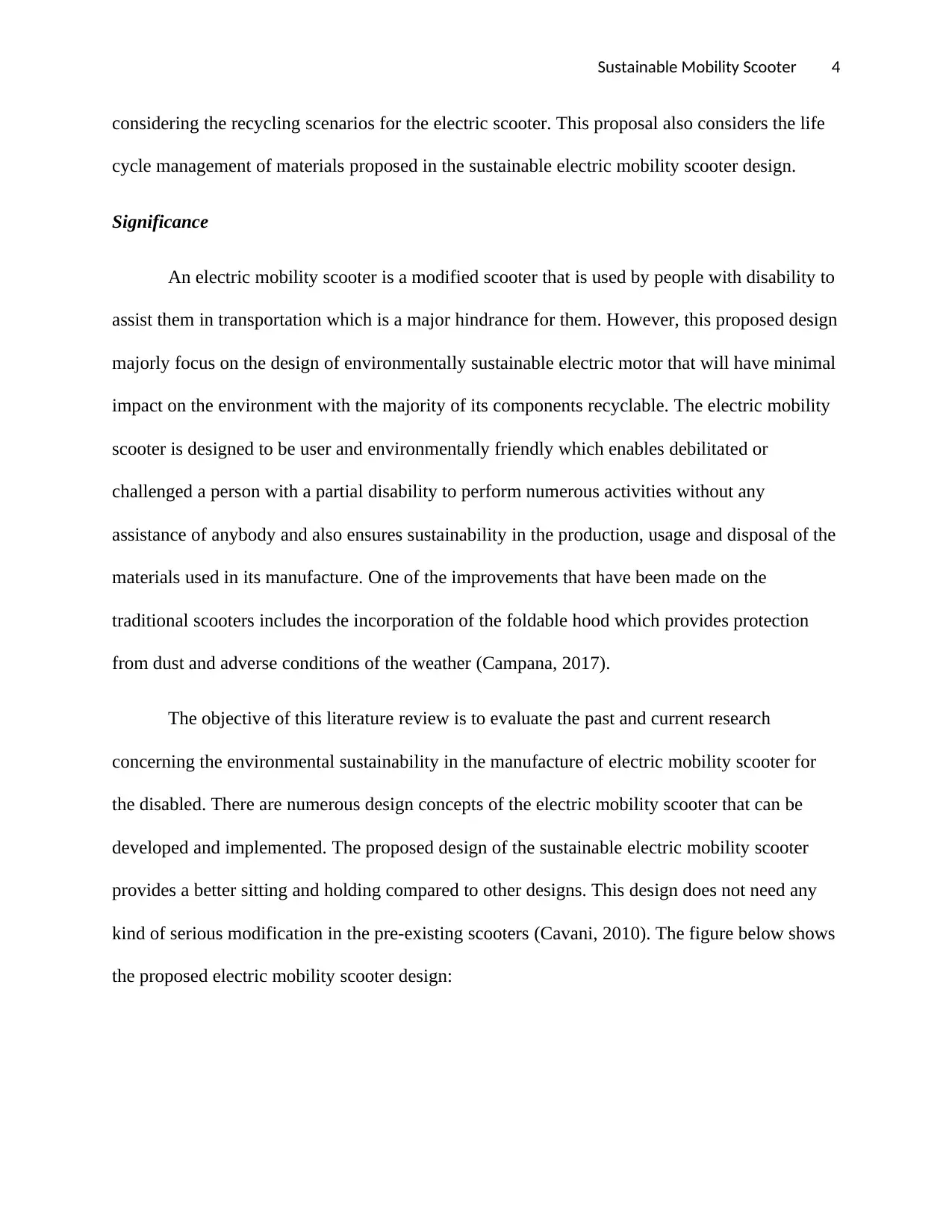
Sustainable Mobility Scooter 4
considering the recycling scenarios for the electric scooter. This proposal also considers the life
cycle management of materials proposed in the sustainable electric mobility scooter design.
Significance
An electric mobility scooter is a modified scooter that is used by people with disability to
assist them in transportation which is a major hindrance for them. However, this proposed design
majorly focus on the design of environmentally sustainable electric motor that will have minimal
impact on the environment with the majority of its components recyclable. The electric mobility
scooter is designed to be user and environmentally friendly which enables debilitated or
challenged a person with a partial disability to perform numerous activities without any
assistance of anybody and also ensures sustainability in the production, usage and disposal of the
materials used in its manufacture. One of the improvements that have been made on the
traditional scooters includes the incorporation of the foldable hood which provides protection
from dust and adverse conditions of the weather (Campana, 2017).
The objective of this literature review is to evaluate the past and current research
concerning the environmental sustainability in the manufacture of electric mobility scooter for
the disabled. There are numerous design concepts of the electric mobility scooter that can be
developed and implemented. The proposed design of the sustainable electric mobility scooter
provides a better sitting and holding compared to other designs. This design does not need any
kind of serious modification in the pre-existing scooters (Cavani, 2010). The figure below shows
the proposed electric mobility scooter design:
considering the recycling scenarios for the electric scooter. This proposal also considers the life
cycle management of materials proposed in the sustainable electric mobility scooter design.
Significance
An electric mobility scooter is a modified scooter that is used by people with disability to
assist them in transportation which is a major hindrance for them. However, this proposed design
majorly focus on the design of environmentally sustainable electric motor that will have minimal
impact on the environment with the majority of its components recyclable. The electric mobility
scooter is designed to be user and environmentally friendly which enables debilitated or
challenged a person with a partial disability to perform numerous activities without any
assistance of anybody and also ensures sustainability in the production, usage and disposal of the
materials used in its manufacture. One of the improvements that have been made on the
traditional scooters includes the incorporation of the foldable hood which provides protection
from dust and adverse conditions of the weather (Campana, 2017).
The objective of this literature review is to evaluate the past and current research
concerning the environmental sustainability in the manufacture of electric mobility scooter for
the disabled. There are numerous design concepts of the electric mobility scooter that can be
developed and implemented. The proposed design of the sustainable electric mobility scooter
provides a better sitting and holding compared to other designs. This design does not need any
kind of serious modification in the pre-existing scooters (Cavani, 2010). The figure below shows
the proposed electric mobility scooter design:
Secure Best Marks with AI Grader
Need help grading? Try our AI Grader for instant feedback on your assignments.
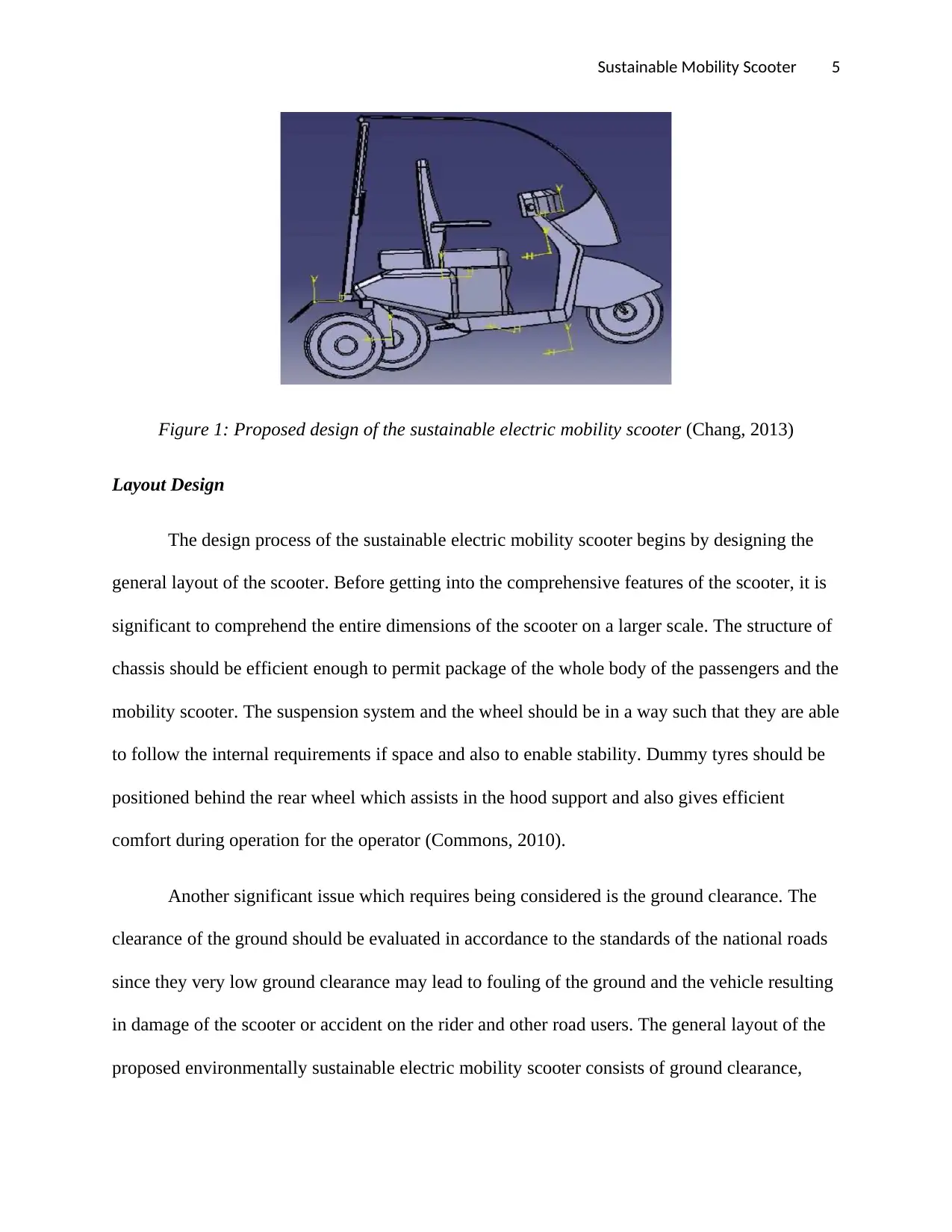
Sustainable Mobility Scooter 5
Figure 1: Proposed design of the sustainable electric mobility scooter (Chang, 2013)
Layout Design
The design process of the sustainable electric mobility scooter begins by designing the
general layout of the scooter. Before getting into the comprehensive features of the scooter, it is
significant to comprehend the entire dimensions of the scooter on a larger scale. The structure of
chassis should be efficient enough to permit package of the whole body of the passengers and the
mobility scooter. The suspension system and the wheel should be in a way such that they are able
to follow the internal requirements if space and also to enable stability. Dummy tyres should be
positioned behind the rear wheel which assists in the hood support and also gives efficient
comfort during operation for the operator (Commons, 2010).
Another significant issue which requires being considered is the ground clearance. The
clearance of the ground should be evaluated in accordance to the standards of the national roads
since they very low ground clearance may lead to fouling of the ground and the vehicle resulting
in damage of the scooter or accident on the rider and other road users. The general layout of the
proposed environmentally sustainable electric mobility scooter consists of ground clearance,
Figure 1: Proposed design of the sustainable electric mobility scooter (Chang, 2013)
Layout Design
The design process of the sustainable electric mobility scooter begins by designing the
general layout of the scooter. Before getting into the comprehensive features of the scooter, it is
significant to comprehend the entire dimensions of the scooter on a larger scale. The structure of
chassis should be efficient enough to permit package of the whole body of the passengers and the
mobility scooter. The suspension system and the wheel should be in a way such that they are able
to follow the internal requirements if space and also to enable stability. Dummy tyres should be
positioned behind the rear wheel which assists in the hood support and also gives efficient
comfort during operation for the operator (Commons, 2010).
Another significant issue which requires being considered is the ground clearance. The
clearance of the ground should be evaluated in accordance to the standards of the national roads
since they very low ground clearance may lead to fouling of the ground and the vehicle resulting
in damage of the scooter or accident on the rider and other road users. The general layout of the
proposed environmentally sustainable electric mobility scooter consists of ground clearance,
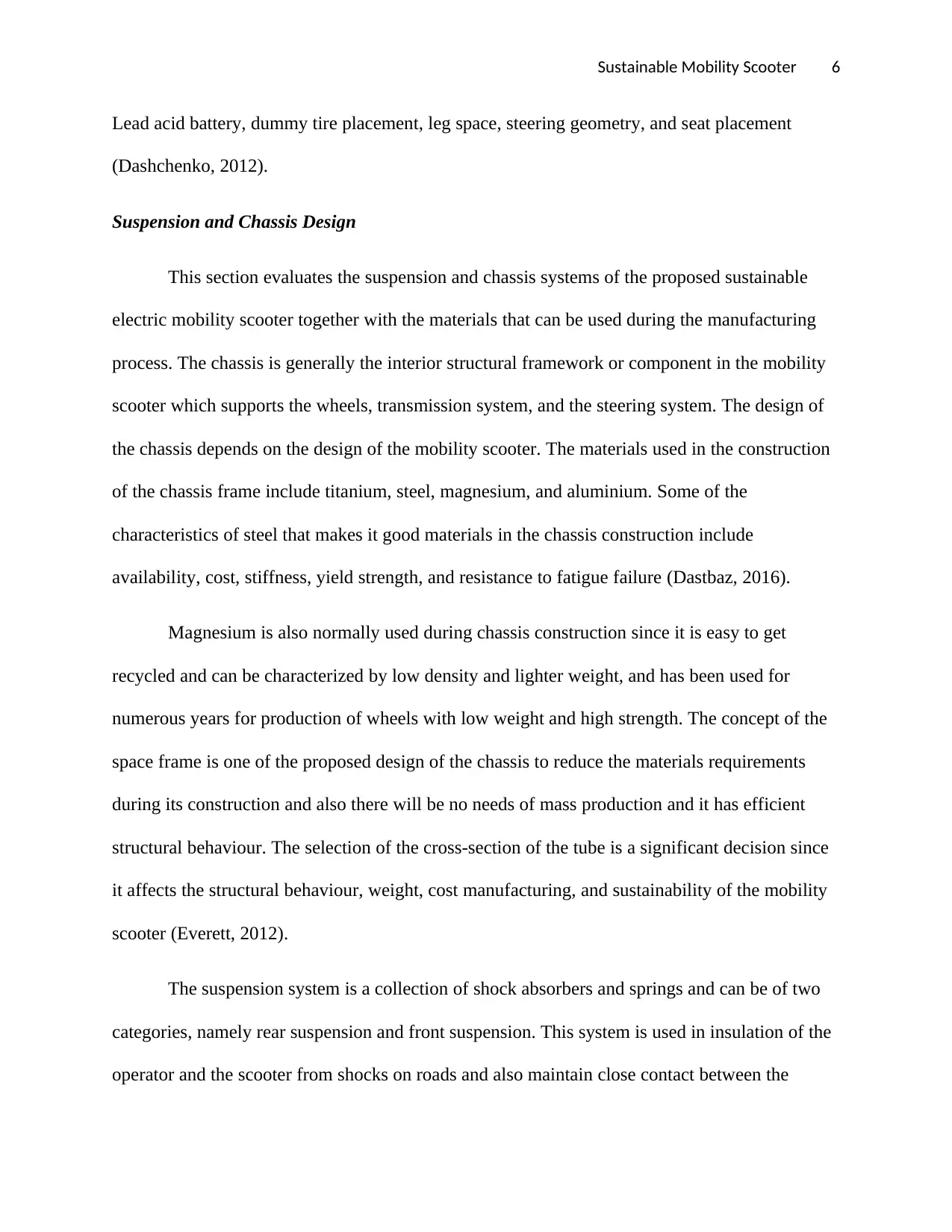
Sustainable Mobility Scooter 6
Lead acid battery, dummy tire placement, leg space, steering geometry, and seat placement
(Dashchenko, 2012).
Suspension and Chassis Design
This section evaluates the suspension and chassis systems of the proposed sustainable
electric mobility scooter together with the materials that can be used during the manufacturing
process. The chassis is generally the interior structural framework or component in the mobility
scooter which supports the wheels, transmission system, and the steering system. The design of
the chassis depends on the design of the mobility scooter. The materials used in the construction
of the chassis frame include titanium, steel, magnesium, and aluminium. Some of the
characteristics of steel that makes it good materials in the chassis construction include
availability, cost, stiffness, yield strength, and resistance to fatigue failure (Dastbaz, 2016).
Magnesium is also normally used during chassis construction since it is easy to get
recycled and can be characterized by low density and lighter weight, and has been used for
numerous years for production of wheels with low weight and high strength. The concept of the
space frame is one of the proposed design of the chassis to reduce the materials requirements
during its construction and also there will be no needs of mass production and it has efficient
structural behaviour. The selection of the cross-section of the tube is a significant decision since
it affects the structural behaviour, weight, cost manufacturing, and sustainability of the mobility
scooter (Everett, 2012).
The suspension system is a collection of shock absorbers and springs and can be of two
categories, namely rear suspension and front suspension. This system is used in insulation of the
operator and the scooter from shocks on roads and also maintain close contact between the
Lead acid battery, dummy tire placement, leg space, steering geometry, and seat placement
(Dashchenko, 2012).
Suspension and Chassis Design
This section evaluates the suspension and chassis systems of the proposed sustainable
electric mobility scooter together with the materials that can be used during the manufacturing
process. The chassis is generally the interior structural framework or component in the mobility
scooter which supports the wheels, transmission system, and the steering system. The design of
the chassis depends on the design of the mobility scooter. The materials used in the construction
of the chassis frame include titanium, steel, magnesium, and aluminium. Some of the
characteristics of steel that makes it good materials in the chassis construction include
availability, cost, stiffness, yield strength, and resistance to fatigue failure (Dastbaz, 2016).
Magnesium is also normally used during chassis construction since it is easy to get
recycled and can be characterized by low density and lighter weight, and has been used for
numerous years for production of wheels with low weight and high strength. The concept of the
space frame is one of the proposed design of the chassis to reduce the materials requirements
during its construction and also there will be no needs of mass production and it has efficient
structural behaviour. The selection of the cross-section of the tube is a significant decision since
it affects the structural behaviour, weight, cost manufacturing, and sustainability of the mobility
scooter (Everett, 2012).
The suspension system is a collection of shock absorbers and springs and can be of two
categories, namely rear suspension and front suspension. This system is used in insulation of the
operator and the scooter from shocks on roads and also maintain close contact between the

Sustainable Mobility Scooter 7
wheels and the ground surface so as to provide control of the scooter to the operator. The front
system of suspension enables front wheels to suspend down and up hence providing a
comfortable ride. The major components of the steering geometry include the steering axis angle
and wheelbase which determines the longitudinal stability of the mobility scooter since a vehicle
with a long wheelbase may be difficult to balance during motion and in case the vehicle has
small base of wheel, then it will be difficult to operate when in static condition (Gallaud, 2016).
Aerodynamics of the Scooter Body
This is a significant factor when designing a sustainable electric mobility scooter since it
affects the energy consumption of the vehicle during operation. This force is generally composed
of drag and lift force. There is need of making a huge front of the scooter which slashes the air
into numerous windscreen and streams. The scooter’s weight acts as a significant factor and
generates torque which provides stability in a direction (Haggar, 2010).
RESEARCH QUESTION
Are the current electric mobility scooter sustainable?
What are some of the impacts of the traditional mobility scooter?
Which are some of the components used in the traditional scooters that are the major
pollutants of the environment?
Which are some of the ways through which mobility scooter can be made to be
sustainable?
Which are some of the components used in the current mobility scooter that should be
replaced or reduced?
METHODOLOGY
The strategy of designing an environmentally sustainable electric mobility scooter can be
attained by evaluating all recycling and reuse technologies and also disassembly processes. The
proposed sustainable mobility scooter can be designed by first evaluating the functional groups
wheels and the ground surface so as to provide control of the scooter to the operator. The front
system of suspension enables front wheels to suspend down and up hence providing a
comfortable ride. The major components of the steering geometry include the steering axis angle
and wheelbase which determines the longitudinal stability of the mobility scooter since a vehicle
with a long wheelbase may be difficult to balance during motion and in case the vehicle has
small base of wheel, then it will be difficult to operate when in static condition (Gallaud, 2016).
Aerodynamics of the Scooter Body
This is a significant factor when designing a sustainable electric mobility scooter since it
affects the energy consumption of the vehicle during operation. This force is generally composed
of drag and lift force. There is need of making a huge front of the scooter which slashes the air
into numerous windscreen and streams. The scooter’s weight acts as a significant factor and
generates torque which provides stability in a direction (Haggar, 2010).
RESEARCH QUESTION
Are the current electric mobility scooter sustainable?
What are some of the impacts of the traditional mobility scooter?
Which are some of the components used in the traditional scooters that are the major
pollutants of the environment?
Which are some of the ways through which mobility scooter can be made to be
sustainable?
Which are some of the components used in the current mobility scooter that should be
replaced or reduced?
METHODOLOGY
The strategy of designing an environmentally sustainable electric mobility scooter can be
attained by evaluating all recycling and reuse technologies and also disassembly processes. The
proposed sustainable mobility scooter can be designed by first evaluating the functional groups
Paraphrase This Document
Need a fresh take? Get an instant paraphrase of this document with our AI Paraphraser
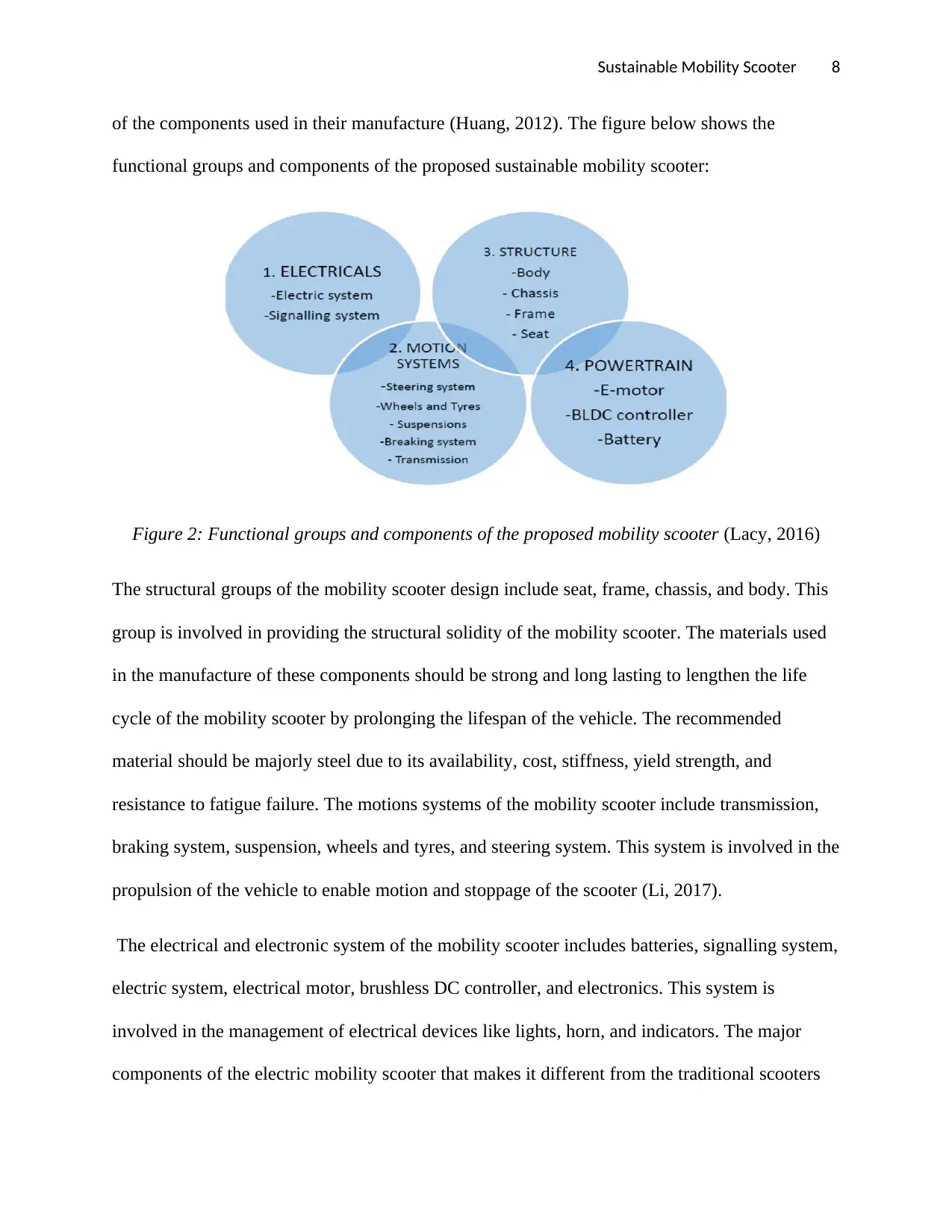
Sustainable Mobility Scooter 8
of the components used in their manufacture (Huang, 2012). The figure below shows the
functional groups and components of the proposed sustainable mobility scooter:
Figure 2: Functional groups and components of the proposed mobility scooter (Lacy, 2016)
The structural groups of the mobility scooter design include seat, frame, chassis, and body. This
group is involved in providing the structural solidity of the mobility scooter. The materials used
in the manufacture of these components should be strong and long lasting to lengthen the life
cycle of the mobility scooter by prolonging the lifespan of the vehicle. The recommended
material should be majorly steel due to its availability, cost, stiffness, yield strength, and
resistance to fatigue failure. The motions systems of the mobility scooter include transmission,
braking system, suspension, wheels and tyres, and steering system. This system is involved in the
propulsion of the vehicle to enable motion and stoppage of the scooter (Li, 2017).
The electrical and electronic system of the mobility scooter includes batteries, signalling system,
electric system, electrical motor, brushless DC controller, and electronics. This system is
involved in the management of electrical devices like lights, horn, and indicators. The major
components of the electric mobility scooter that makes it different from the traditional scooters
of the components used in their manufacture (Huang, 2012). The figure below shows the
functional groups and components of the proposed sustainable mobility scooter:
Figure 2: Functional groups and components of the proposed mobility scooter (Lacy, 2016)
The structural groups of the mobility scooter design include seat, frame, chassis, and body. This
group is involved in providing the structural solidity of the mobility scooter. The materials used
in the manufacture of these components should be strong and long lasting to lengthen the life
cycle of the mobility scooter by prolonging the lifespan of the vehicle. The recommended
material should be majorly steel due to its availability, cost, stiffness, yield strength, and
resistance to fatigue failure. The motions systems of the mobility scooter include transmission,
braking system, suspension, wheels and tyres, and steering system. This system is involved in the
propulsion of the vehicle to enable motion and stoppage of the scooter (Li, 2017).
The electrical and electronic system of the mobility scooter includes batteries, signalling system,
electric system, electrical motor, brushless DC controller, and electronics. This system is
involved in the management of electrical devices like lights, horn, and indicators. The major
components of the electric mobility scooter that makes it different from the traditional scooters

Sustainable Mobility Scooter 9
include the electric motor and the batteries. There is a flow of current in the stator and provides a
momentum to the rotor which is coupled with the axle of the wheels (MacArthur, 2015).
Waste Management
One of the proposed major directives towards environmentally electric mobility scooter is
the management of waste from the disposed or damaged mobility scooter so as to protect human
health and also the environment. Just like other standard vehicles, the first procedure of waste
scoter management involves receiving the scooter this disassembly of the parts by first removing
the hazardous components such as transmission oils, fluids, and batteries. These materials should
be kept in a safe stock to prevent spillage. The next step of disassembly is to remove the valuable
parts of the mobility scooter. These valuable components can be reused as spare parts for other
scooters which are in operation. The remaining components of the scooter can be divided into
tyres, polymers, and metals during the recycling process (Manna, 2011).
The metals are the most significant materials especially magnesium, aluminium, and
copper and can be recycled through meeting followed by cooling into required structural
components. There are proposed strategies for recycling and prevention of waste toward a more
sustainable and effective management of waste. One of the waste management strategies is the
reduction in the size and weight of the majority of the components used in the manufacture of the
mobility scooter. When the weight of the components is reduced, the energy consumption will
also be reduced since the vehicle will be lighter and the energy required to propel it will
significantly reduce. Some of the components that their weight and sizes should be reduced
include seat, frame, chassis, and body (McCotter, 2009).
include the electric motor and the batteries. There is a flow of current in the stator and provides a
momentum to the rotor which is coupled with the axle of the wheels (MacArthur, 2015).
Waste Management
One of the proposed major directives towards environmentally electric mobility scooter is
the management of waste from the disposed or damaged mobility scooter so as to protect human
health and also the environment. Just like other standard vehicles, the first procedure of waste
scoter management involves receiving the scooter this disassembly of the parts by first removing
the hazardous components such as transmission oils, fluids, and batteries. These materials should
be kept in a safe stock to prevent spillage. The next step of disassembly is to remove the valuable
parts of the mobility scooter. These valuable components can be reused as spare parts for other
scooters which are in operation. The remaining components of the scooter can be divided into
tyres, polymers, and metals during the recycling process (Manna, 2011).
The metals are the most significant materials especially magnesium, aluminium, and
copper and can be recycled through meeting followed by cooling into required structural
components. There are proposed strategies for recycling and prevention of waste toward a more
sustainable and effective management of waste. One of the waste management strategies is the
reduction in the size and weight of the majority of the components used in the manufacture of the
mobility scooter. When the weight of the components is reduced, the energy consumption will
also be reduced since the vehicle will be lighter and the energy required to propel it will
significantly reduce. Some of the components that their weight and sizes should be reduced
include seat, frame, chassis, and body (McCotter, 2009).
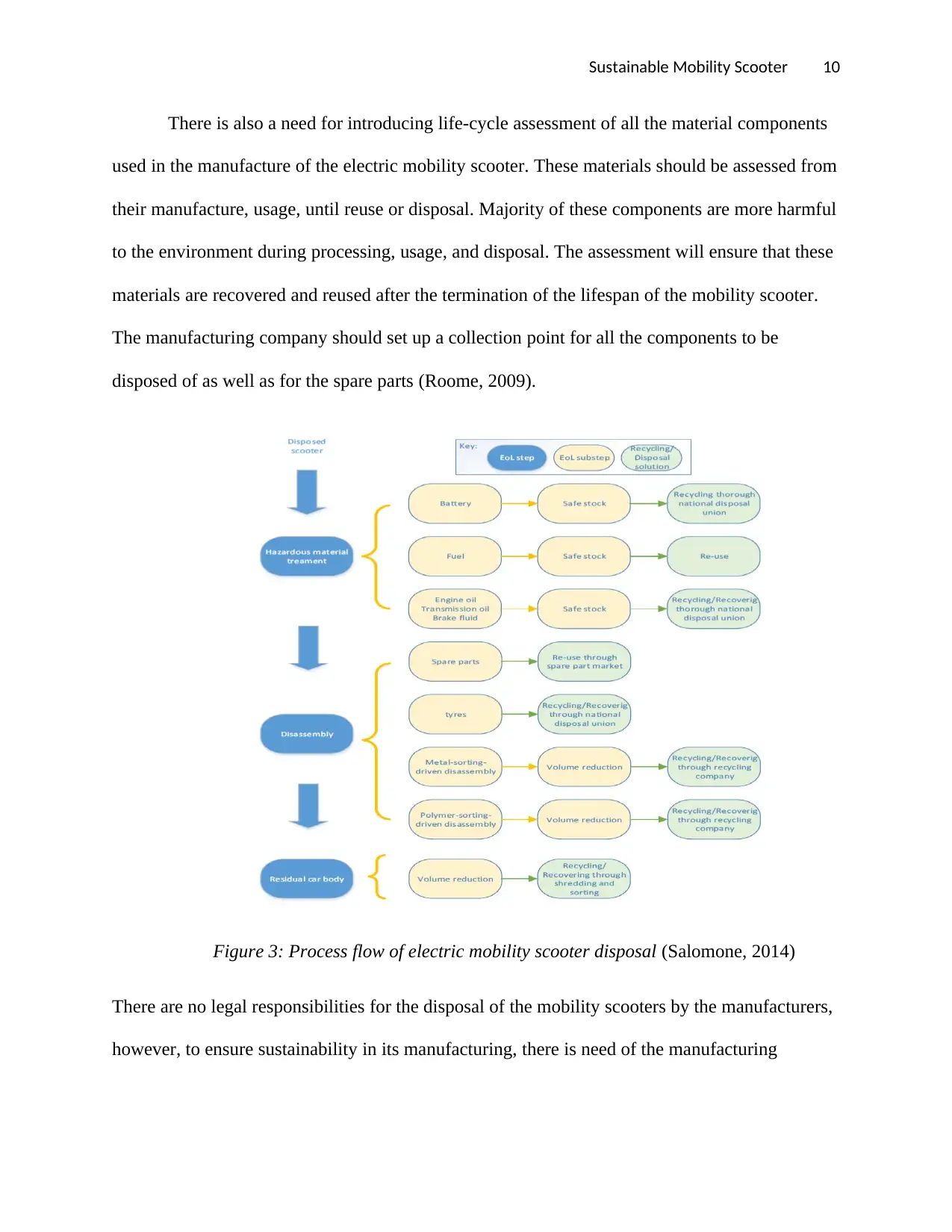
Sustainable Mobility Scooter 10
There is also a need for introducing life-cycle assessment of all the material components
used in the manufacture of the electric mobility scooter. These materials should be assessed from
their manufacture, usage, until reuse or disposal. Majority of these components are more harmful
to the environment during processing, usage, and disposal. The assessment will ensure that these
materials are recovered and reused after the termination of the lifespan of the mobility scooter.
The manufacturing company should set up a collection point for all the components to be
disposed of as well as for the spare parts (Roome, 2009).
Figure 3: Process flow of electric mobility scooter disposal (Salomone, 2014)
There are no legal responsibilities for the disposal of the mobility scooters by the manufacturers,
however, to ensure sustainability in its manufacturing, there is need of the manufacturing
There is also a need for introducing life-cycle assessment of all the material components
used in the manufacture of the electric mobility scooter. These materials should be assessed from
their manufacture, usage, until reuse or disposal. Majority of these components are more harmful
to the environment during processing, usage, and disposal. The assessment will ensure that these
materials are recovered and reused after the termination of the lifespan of the mobility scooter.
The manufacturing company should set up a collection point for all the components to be
disposed of as well as for the spare parts (Roome, 2009).
Figure 3: Process flow of electric mobility scooter disposal (Salomone, 2014)
There are no legal responsibilities for the disposal of the mobility scooters by the manufacturers,
however, to ensure sustainability in its manufacturing, there is need of the manufacturing
Secure Best Marks with AI Grader
Need help grading? Try our AI Grader for instant feedback on your assignments.
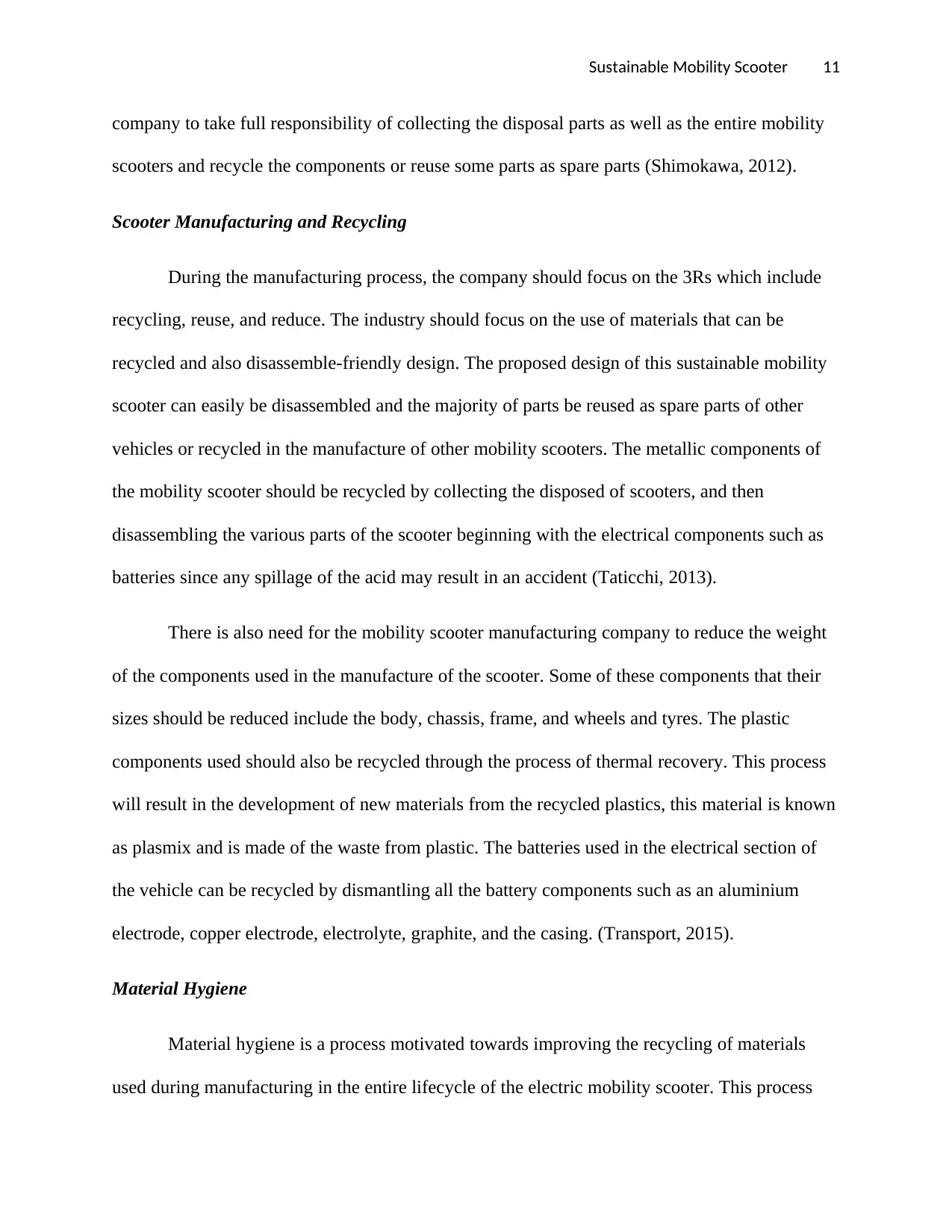
Sustainable Mobility Scooter 11
company to take full responsibility of collecting the disposal parts as well as the entire mobility
scooters and recycle the components or reuse some parts as spare parts (Shimokawa, 2012).
Scooter Manufacturing and Recycling
During the manufacturing process, the company should focus on the 3Rs which include
recycling, reuse, and reduce. The industry should focus on the use of materials that can be
recycled and also disassemble-friendly design. The proposed design of this sustainable mobility
scooter can easily be disassembled and the majority of parts be reused as spare parts of other
vehicles or recycled in the manufacture of other mobility scooters. The metallic components of
the mobility scooter should be recycled by collecting the disposed of scooters, and then
disassembling the various parts of the scooter beginning with the electrical components such as
batteries since any spillage of the acid may result in an accident (Taticchi, 2013).
There is also need for the mobility scooter manufacturing company to reduce the weight
of the components used in the manufacture of the scooter. Some of these components that their
sizes should be reduced include the body, chassis, frame, and wheels and tyres. The plastic
components used should also be recycled through the process of thermal recovery. This process
will result in the development of new materials from the recycled plastics, this material is known
as plasmix and is made of the waste from plastic. The batteries used in the electrical section of
the vehicle can be recycled by dismantling all the battery components such as an aluminium
electrode, copper electrode, electrolyte, graphite, and the casing. (Transport, 2015).
Material Hygiene
Material hygiene is a process motivated towards improving the recycling of materials
used during manufacturing in the entire lifecycle of the electric mobility scooter. This process
company to take full responsibility of collecting the disposal parts as well as the entire mobility
scooters and recycle the components or reuse some parts as spare parts (Shimokawa, 2012).
Scooter Manufacturing and Recycling
During the manufacturing process, the company should focus on the 3Rs which include
recycling, reuse, and reduce. The industry should focus on the use of materials that can be
recycled and also disassemble-friendly design. The proposed design of this sustainable mobility
scooter can easily be disassembled and the majority of parts be reused as spare parts of other
vehicles or recycled in the manufacture of other mobility scooters. The metallic components of
the mobility scooter should be recycled by collecting the disposed of scooters, and then
disassembling the various parts of the scooter beginning with the electrical components such as
batteries since any spillage of the acid may result in an accident (Taticchi, 2013).
There is also need for the mobility scooter manufacturing company to reduce the weight
of the components used in the manufacture of the scooter. Some of these components that their
sizes should be reduced include the body, chassis, frame, and wheels and tyres. The plastic
components used should also be recycled through the process of thermal recovery. This process
will result in the development of new materials from the recycled plastics, this material is known
as plasmix and is made of the waste from plastic. The batteries used in the electrical section of
the vehicle can be recycled by dismantling all the battery components such as an aluminium
electrode, copper electrode, electrolyte, graphite, and the casing. (Transport, 2015).
Material Hygiene
Material hygiene is a process motivated towards improving the recycling of materials
used during manufacturing in the entire lifecycle of the electric mobility scooter. This process
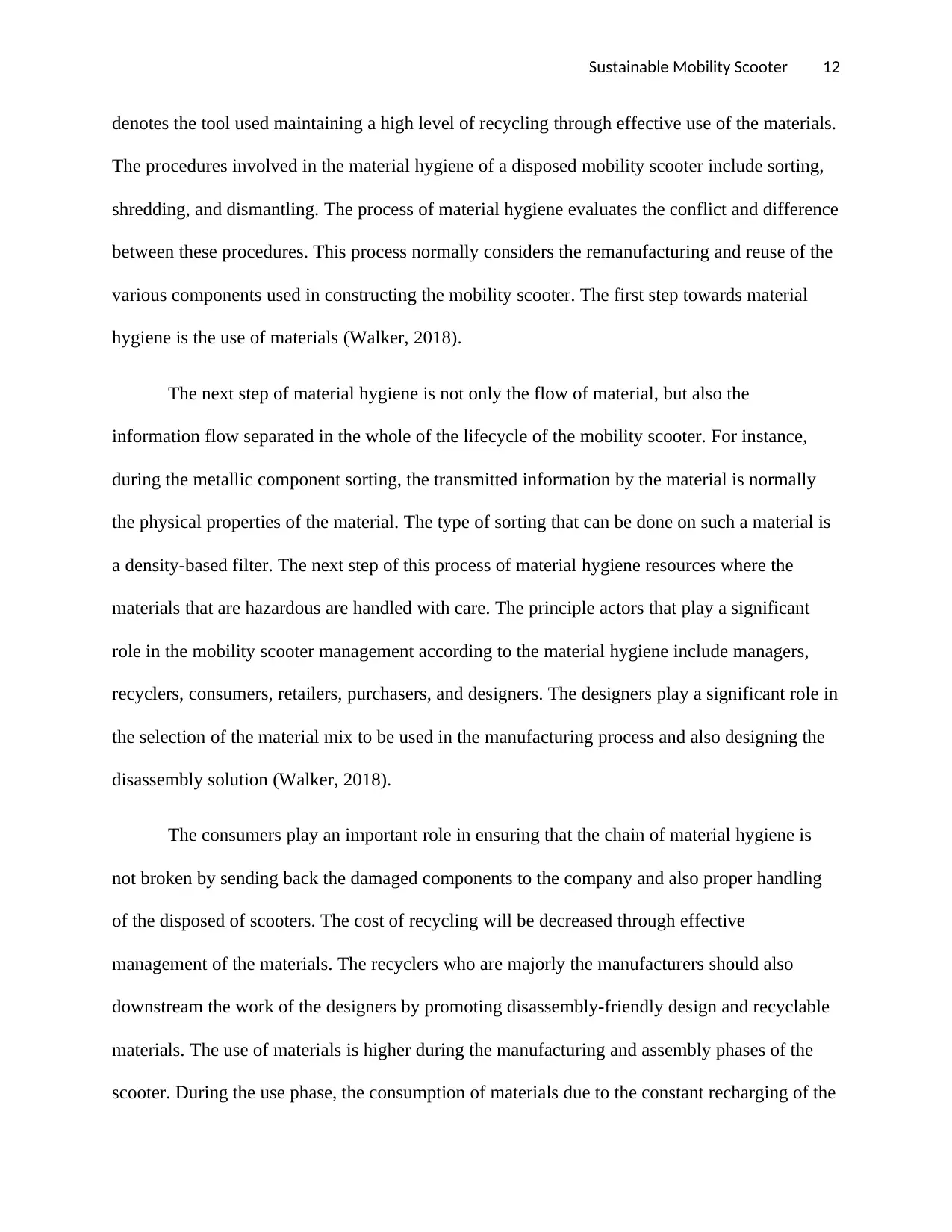
Sustainable Mobility Scooter 12
denotes the tool used maintaining a high level of recycling through effective use of the materials.
The procedures involved in the material hygiene of a disposed mobility scooter include sorting,
shredding, and dismantling. The process of material hygiene evaluates the conflict and difference
between these procedures. This process normally considers the remanufacturing and reuse of the
various components used in constructing the mobility scooter. The first step towards material
hygiene is the use of materials (Walker, 2018).
The next step of material hygiene is not only the flow of material, but also the
information flow separated in the whole of the lifecycle of the mobility scooter. For instance,
during the metallic component sorting, the transmitted information by the material is normally
the physical properties of the material. The type of sorting that can be done on such a material is
a density-based filter. The next step of this process of material hygiene resources where the
materials that are hazardous are handled with care. The principle actors that play a significant
role in the mobility scooter management according to the material hygiene include managers,
recyclers, consumers, retailers, purchasers, and designers. The designers play a significant role in
the selection of the material mix to be used in the manufacturing process and also designing the
disassembly solution (Walker, 2018).
The consumers play an important role in ensuring that the chain of material hygiene is
not broken by sending back the damaged components to the company and also proper handling
of the disposed of scooters. The cost of recycling will be decreased through effective
management of the materials. The recyclers who are majorly the manufacturers should also
downstream the work of the designers by promoting disassembly-friendly design and recyclable
materials. The use of materials is higher during the manufacturing and assembly phases of the
scooter. During the use phase, the consumption of materials due to the constant recharging of the
denotes the tool used maintaining a high level of recycling through effective use of the materials.
The procedures involved in the material hygiene of a disposed mobility scooter include sorting,
shredding, and dismantling. The process of material hygiene evaluates the conflict and difference
between these procedures. This process normally considers the remanufacturing and reuse of the
various components used in constructing the mobility scooter. The first step towards material
hygiene is the use of materials (Walker, 2018).
The next step of material hygiene is not only the flow of material, but also the
information flow separated in the whole of the lifecycle of the mobility scooter. For instance,
during the metallic component sorting, the transmitted information by the material is normally
the physical properties of the material. The type of sorting that can be done on such a material is
a density-based filter. The next step of this process of material hygiene resources where the
materials that are hazardous are handled with care. The principle actors that play a significant
role in the mobility scooter management according to the material hygiene include managers,
recyclers, consumers, retailers, purchasers, and designers. The designers play a significant role in
the selection of the material mix to be used in the manufacturing process and also designing the
disassembly solution (Walker, 2018).
The consumers play an important role in ensuring that the chain of material hygiene is
not broken by sending back the damaged components to the company and also proper handling
of the disposed of scooters. The cost of recycling will be decreased through effective
management of the materials. The recyclers who are majorly the manufacturers should also
downstream the work of the designers by promoting disassembly-friendly design and recyclable
materials. The use of materials is higher during the manufacturing and assembly phases of the
scooter. During the use phase, the consumption of materials due to the constant recharging of the

Sustainable Mobility Scooter 13
lead-acid batteries used by the electric mobility scooter. The users also incur the cost of
maintenance especially on the moving parts of the vehicle. The batteries also should be checked
and diluted water added (Webster, 2017).
Dissemination of Findings
After the evaluation of various ways in which the electric mobility scooter can be made
environmentally sustainable, the findings should be disseminated to various people dealing in the
manufacturing of scooters and also other types of vehicles. Some of these findings target
consumers, manufacturers, retailers, or designers and all of them have an important role to play
so as to ensure that there is circular material flow in the entire life cycle assessment of the
electric mobility scooter. These findings can be disseminated through writing research papers
concerning the sustainability of electric mobility scooter and then publish them in research
journals so that they can be accessed by different designers and manufacturers who may be
researching of different designs of constructing the mobility scooters (Dashchenko, 2012). Some
of the papers that can be used as a publication media for the findings include The Advertiser,
Brisbane Times (online), Queensland Asian Business Weekly, The Catholic Leader, and The
Australia.
Approximately 60% of the targeted groups will access the research since a large number
of designers and manufacturers of mobility scooter are currently facing stiff competition with
their competitors and hence the research teams are constantly researching on better ways of
delivering their products. However, there is a small percentage of the intended population that
will not access this research since there is usually some companies that do not like change within
their structure of operation and will consider the implementation of these policies as an extra cost
that the company cannot incur (Dashchenko, 2012).
lead-acid batteries used by the electric mobility scooter. The users also incur the cost of
maintenance especially on the moving parts of the vehicle. The batteries also should be checked
and diluted water added (Webster, 2017).
Dissemination of Findings
After the evaluation of various ways in which the electric mobility scooter can be made
environmentally sustainable, the findings should be disseminated to various people dealing in the
manufacturing of scooters and also other types of vehicles. Some of these findings target
consumers, manufacturers, retailers, or designers and all of them have an important role to play
so as to ensure that there is circular material flow in the entire life cycle assessment of the
electric mobility scooter. These findings can be disseminated through writing research papers
concerning the sustainability of electric mobility scooter and then publish them in research
journals so that they can be accessed by different designers and manufacturers who may be
researching of different designs of constructing the mobility scooters (Dashchenko, 2012). Some
of the papers that can be used as a publication media for the findings include The Advertiser,
Brisbane Times (online), Queensland Asian Business Weekly, The Catholic Leader, and The
Australia.
Approximately 60% of the targeted groups will access the research since a large number
of designers and manufacturers of mobility scooter are currently facing stiff competition with
their competitors and hence the research teams are constantly researching on better ways of
delivering their products. However, there is a small percentage of the intended population that
will not access this research since there is usually some companies that do not like change within
their structure of operation and will consider the implementation of these policies as an extra cost
that the company cannot incur (Dashchenko, 2012).
Paraphrase This Document
Need a fresh take? Get an instant paraphrase of this document with our AI Paraphraser
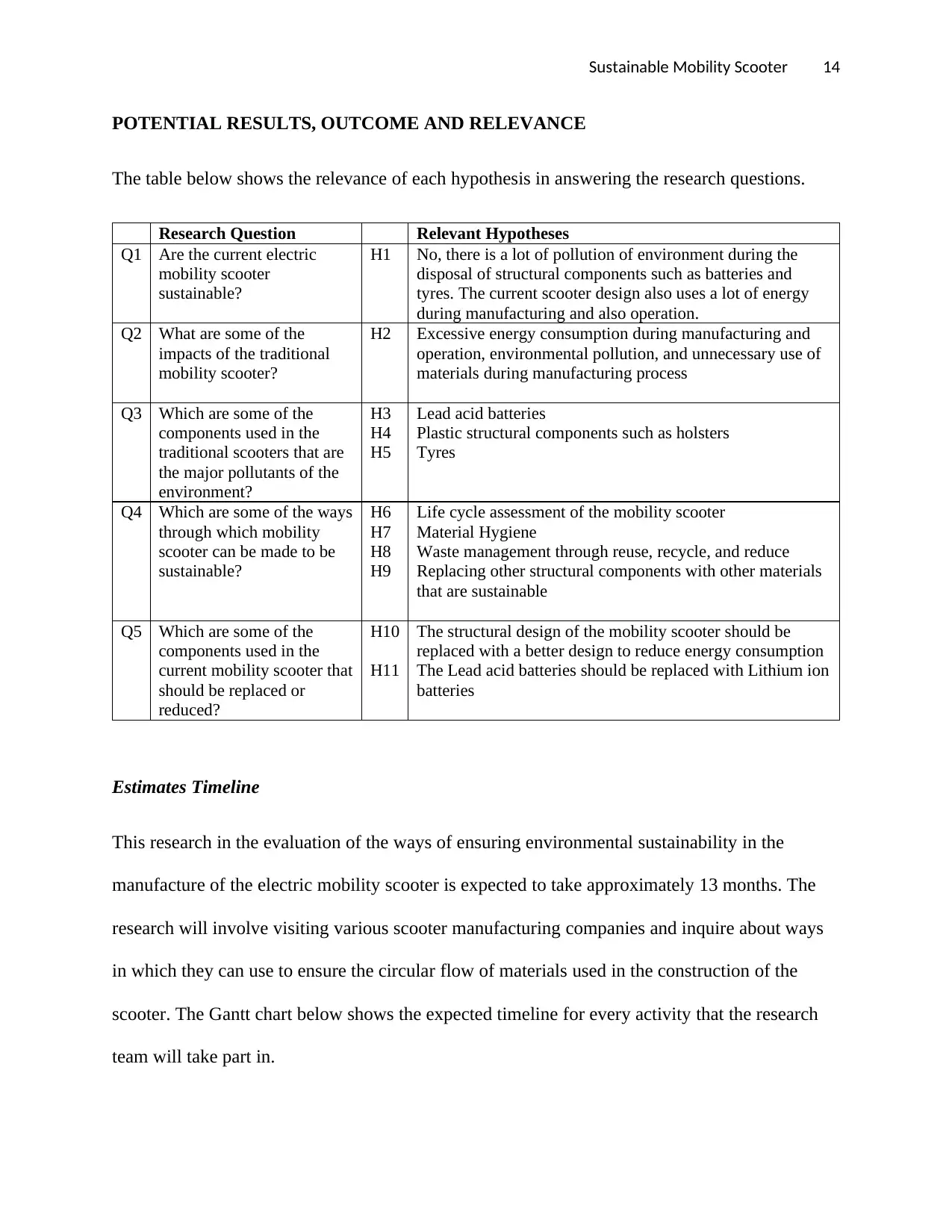
Sustainable Mobility Scooter 14
POTENTIAL RESULTS, OUTCOME AND RELEVANCE
The table below shows the relevance of each hypothesis in answering the research questions.
Research Question Relevant Hypotheses
Q1 Are the current electric
mobility scooter
sustainable?
H1 No, there is a lot of pollution of environment during the
disposal of structural components such as batteries and
tyres. The current scooter design also uses a lot of energy
during manufacturing and also operation.
Q2 What are some of the
impacts of the traditional
mobility scooter?
H2 Excessive energy consumption during manufacturing and
operation, environmental pollution, and unnecessary use of
materials during manufacturing process
Q3 Which are some of the
components used in the
traditional scooters that are
the major pollutants of the
environment?
H3
H4
H5
Lead acid batteries
Plastic structural components such as holsters
Tyres
Q4 Which are some of the ways
through which mobility
scooter can be made to be
sustainable?
H6
H7
H8
H9
Life cycle assessment of the mobility scooter
Material Hygiene
Waste management through reuse, recycle, and reduce
Replacing other structural components with other materials
that are sustainable
Q5 Which are some of the
components used in the
current mobility scooter that
should be replaced or
reduced?
H10
H11
The structural design of the mobility scooter should be
replaced with a better design to reduce energy consumption
The Lead acid batteries should be replaced with Lithium ion
batteries
Estimates Timeline
This research in the evaluation of the ways of ensuring environmental sustainability in the
manufacture of the electric mobility scooter is expected to take approximately 13 months. The
research will involve visiting various scooter manufacturing companies and inquire about ways
in which they can use to ensure the circular flow of materials used in the construction of the
scooter. The Gantt chart below shows the expected timeline for every activity that the research
team will take part in.
POTENTIAL RESULTS, OUTCOME AND RELEVANCE
The table below shows the relevance of each hypothesis in answering the research questions.
Research Question Relevant Hypotheses
Q1 Are the current electric
mobility scooter
sustainable?
H1 No, there is a lot of pollution of environment during the
disposal of structural components such as batteries and
tyres. The current scooter design also uses a lot of energy
during manufacturing and also operation.
Q2 What are some of the
impacts of the traditional
mobility scooter?
H2 Excessive energy consumption during manufacturing and
operation, environmental pollution, and unnecessary use of
materials during manufacturing process
Q3 Which are some of the
components used in the
traditional scooters that are
the major pollutants of the
environment?
H3
H4
H5
Lead acid batteries
Plastic structural components such as holsters
Tyres
Q4 Which are some of the ways
through which mobility
scooter can be made to be
sustainable?
H6
H7
H8
H9
Life cycle assessment of the mobility scooter
Material Hygiene
Waste management through reuse, recycle, and reduce
Replacing other structural components with other materials
that are sustainable
Q5 Which are some of the
components used in the
current mobility scooter that
should be replaced or
reduced?
H10
H11
The structural design of the mobility scooter should be
replaced with a better design to reduce energy consumption
The Lead acid batteries should be replaced with Lithium ion
batteries
Estimates Timeline
This research in the evaluation of the ways of ensuring environmental sustainability in the
manufacture of the electric mobility scooter is expected to take approximately 13 months. The
research will involve visiting various scooter manufacturing companies and inquire about ways
in which they can use to ensure the circular flow of materials used in the construction of the
scooter. The Gantt chart below shows the expected timeline for every activity that the research
team will take part in.
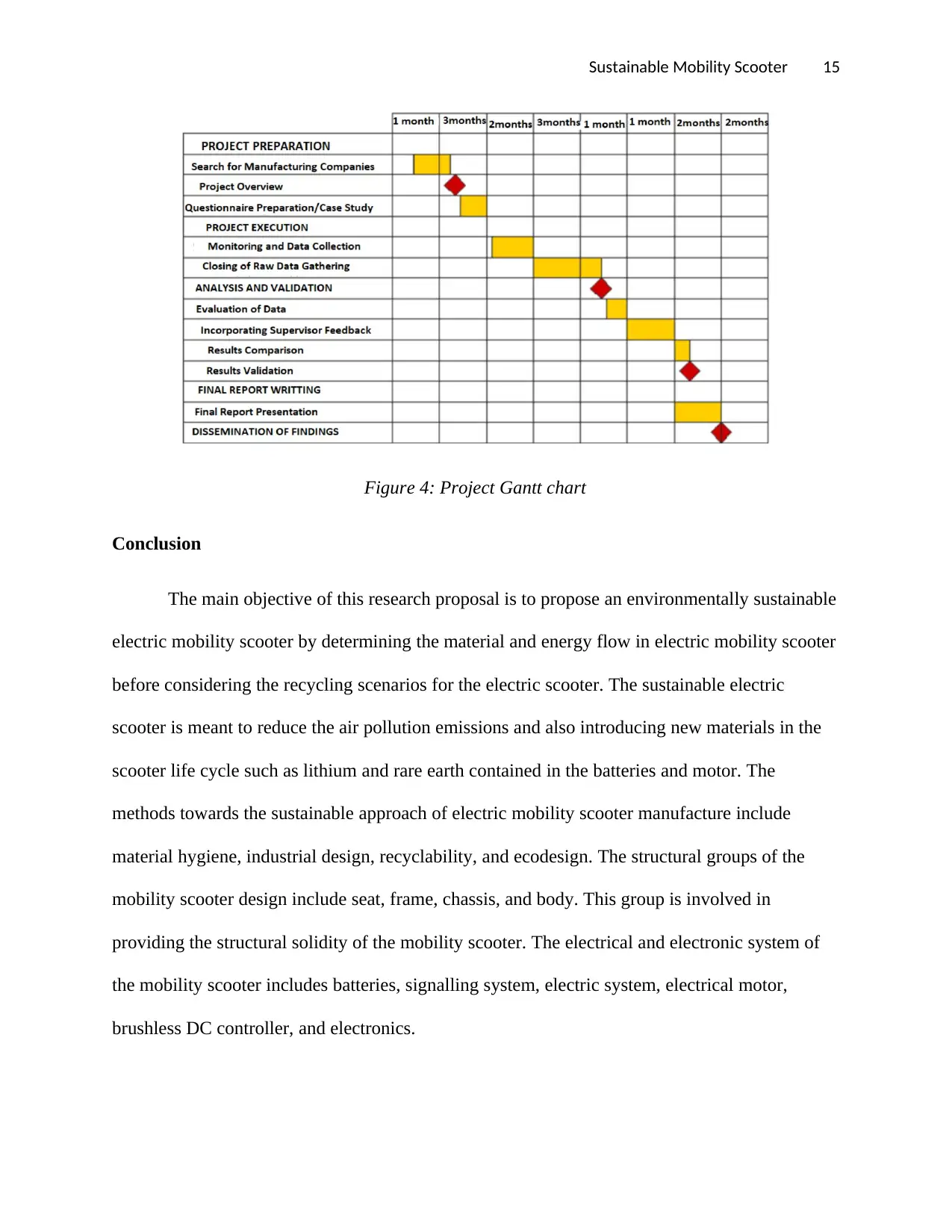
Sustainable Mobility Scooter 15
Figure 4: Project Gantt chart
Conclusion
The main objective of this research proposal is to propose an environmentally sustainable
electric mobility scooter by determining the material and energy flow in electric mobility scooter
before considering the recycling scenarios for the electric scooter. The sustainable electric
scooter is meant to reduce the air pollution emissions and also introducing new materials in the
scooter life cycle such as lithium and rare earth contained in the batteries and motor. The
methods towards the sustainable approach of electric mobility scooter manufacture include
material hygiene, industrial design, recyclability, and ecodesign. The structural groups of the
mobility scooter design include seat, frame, chassis, and body. This group is involved in
providing the structural solidity of the mobility scooter. The electrical and electronic system of
the mobility scooter includes batteries, signalling system, electric system, electrical motor,
brushless DC controller, and electronics.
Figure 4: Project Gantt chart
Conclusion
The main objective of this research proposal is to propose an environmentally sustainable
electric mobility scooter by determining the material and energy flow in electric mobility scooter
before considering the recycling scenarios for the electric scooter. The sustainable electric
scooter is meant to reduce the air pollution emissions and also introducing new materials in the
scooter life cycle such as lithium and rare earth contained in the batteries and motor. The
methods towards the sustainable approach of electric mobility scooter manufacture include
material hygiene, industrial design, recyclability, and ecodesign. The structural groups of the
mobility scooter design include seat, frame, chassis, and body. This group is involved in
providing the structural solidity of the mobility scooter. The electrical and electronic system of
the mobility scooter includes batteries, signalling system, electric system, electrical motor,
brushless DC controller, and electronics.
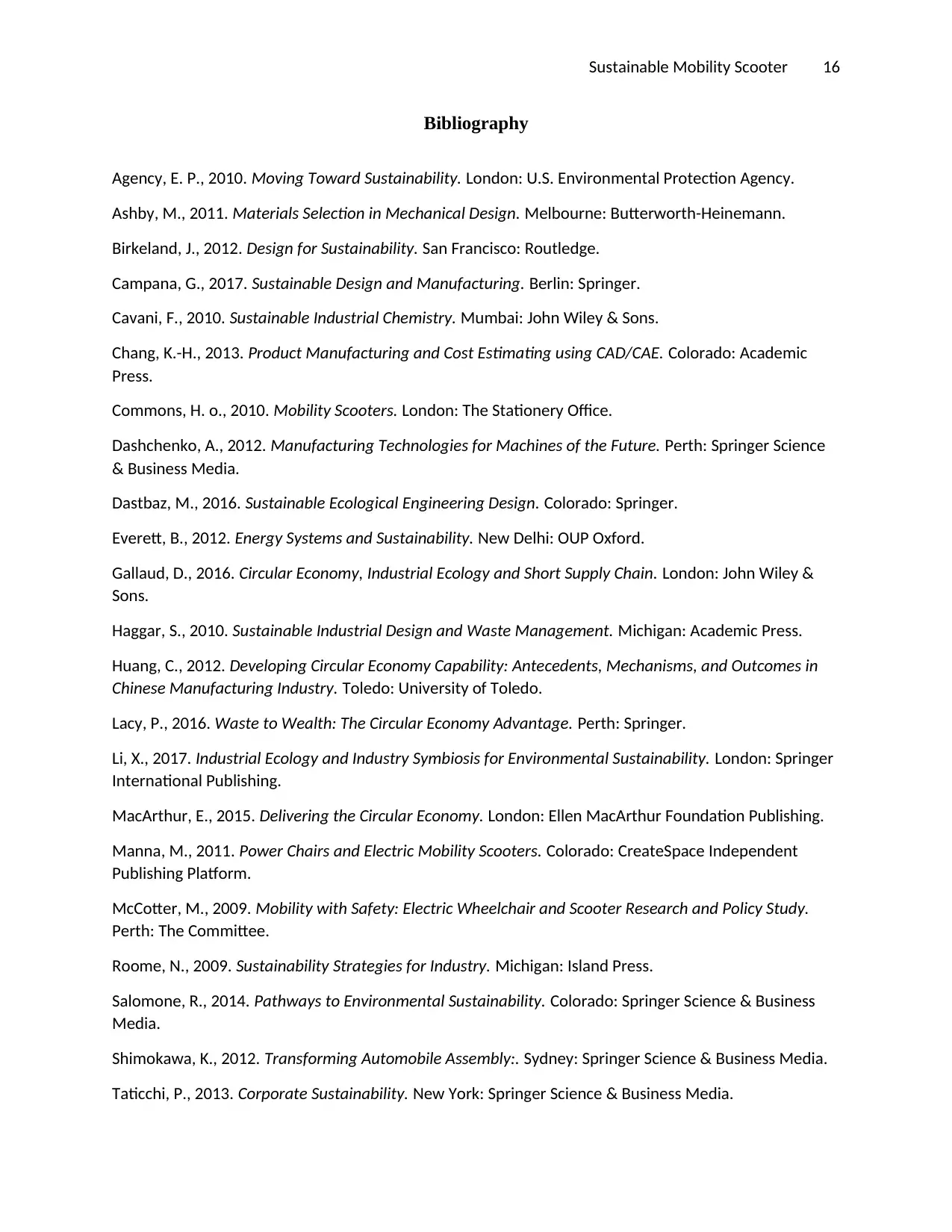
Sustainable Mobility Scooter 16
Bibliography
Agency, E. P., 2010. Moving Toward Sustainability. London: U.S. Environmental Protection Agency.
Ashby, M., 2011. Materials Selection in Mechanical Design. Melbourne: Butterworth-Heinemann.
Birkeland, J., 2012. Design for Sustainability. San Francisco: Routledge.
Campana, G., 2017. Sustainable Design and Manufacturing. Berlin: Springer.
Cavani, F., 2010. Sustainable Industrial Chemistry. Mumbai: John Wiley & Sons.
Chang, K.-H., 2013. Product Manufacturing and Cost Estimating using CAD/CAE. Colorado: Academic
Press.
Commons, H. o., 2010. Mobility Scooters. London: The Stationery Office.
Dashchenko, A., 2012. Manufacturing Technologies for Machines of the Future. Perth: Springer Science
& Business Media.
Dastbaz, M., 2016. Sustainable Ecological Engineering Design. Colorado: Springer.
Everett, B., 2012. Energy Systems and Sustainability. New Delhi: OUP Oxford.
Gallaud, D., 2016. Circular Economy, Industrial Ecology and Short Supply Chain. London: John Wiley &
Sons.
Haggar, S., 2010. Sustainable Industrial Design and Waste Management. Michigan: Academic Press.
Huang, C., 2012. Developing Circular Economy Capability: Antecedents, Mechanisms, and Outcomes in
Chinese Manufacturing Industry. Toledo: University of Toledo.
Lacy, P., 2016. Waste to Wealth: The Circular Economy Advantage. Perth: Springer.
Li, X., 2017. Industrial Ecology and Industry Symbiosis for Environmental Sustainability. London: Springer
International Publishing.
MacArthur, E., 2015. Delivering the Circular Economy. London: Ellen MacArthur Foundation Publishing.
Manna, M., 2011. Power Chairs and Electric Mobility Scooters. Colorado: CreateSpace Independent
Publishing Platform.
McCotter, M., 2009. Mobility with Safety: Electric Wheelchair and Scooter Research and Policy Study.
Perth: The Committee.
Roome, N., 2009. Sustainability Strategies for Industry. Michigan: Island Press.
Salomone, R., 2014. Pathways to Environmental Sustainability. Colorado: Springer Science & Business
Media.
Shimokawa, K., 2012. Transforming Automobile Assembly:. Sydney: Springer Science & Business Media.
Taticchi, P., 2013. Corporate Sustainability. New York: Springer Science & Business Media.
Bibliography
Agency, E. P., 2010. Moving Toward Sustainability. London: U.S. Environmental Protection Agency.
Ashby, M., 2011. Materials Selection in Mechanical Design. Melbourne: Butterworth-Heinemann.
Birkeland, J., 2012. Design for Sustainability. San Francisco: Routledge.
Campana, G., 2017. Sustainable Design and Manufacturing. Berlin: Springer.
Cavani, F., 2010. Sustainable Industrial Chemistry. Mumbai: John Wiley & Sons.
Chang, K.-H., 2013. Product Manufacturing and Cost Estimating using CAD/CAE. Colorado: Academic
Press.
Commons, H. o., 2010. Mobility Scooters. London: The Stationery Office.
Dashchenko, A., 2012. Manufacturing Technologies for Machines of the Future. Perth: Springer Science
& Business Media.
Dastbaz, M., 2016. Sustainable Ecological Engineering Design. Colorado: Springer.
Everett, B., 2012. Energy Systems and Sustainability. New Delhi: OUP Oxford.
Gallaud, D., 2016. Circular Economy, Industrial Ecology and Short Supply Chain. London: John Wiley &
Sons.
Haggar, S., 2010. Sustainable Industrial Design and Waste Management. Michigan: Academic Press.
Huang, C., 2012. Developing Circular Economy Capability: Antecedents, Mechanisms, and Outcomes in
Chinese Manufacturing Industry. Toledo: University of Toledo.
Lacy, P., 2016. Waste to Wealth: The Circular Economy Advantage. Perth: Springer.
Li, X., 2017. Industrial Ecology and Industry Symbiosis for Environmental Sustainability. London: Springer
International Publishing.
MacArthur, E., 2015. Delivering the Circular Economy. London: Ellen MacArthur Foundation Publishing.
Manna, M., 2011. Power Chairs and Electric Mobility Scooters. Colorado: CreateSpace Independent
Publishing Platform.
McCotter, M., 2009. Mobility with Safety: Electric Wheelchair and Scooter Research and Policy Study.
Perth: The Committee.
Roome, N., 2009. Sustainability Strategies for Industry. Michigan: Island Press.
Salomone, R., 2014. Pathways to Environmental Sustainability. Colorado: Springer Science & Business
Media.
Shimokawa, K., 2012. Transforming Automobile Assembly:. Sydney: Springer Science & Business Media.
Taticchi, P., 2013. Corporate Sustainability. New York: Springer Science & Business Media.
Secure Best Marks with AI Grader
Need help grading? Try our AI Grader for instant feedback on your assignments.

Sustainable Mobility Scooter 17
Transport, D. o., 2015. Wheelchairs and Mobility Scooters. New York: Department of Transport and Main
Roads.
Walker, T., 2018. Designing a Sustainable Financial System. Canada: Springer.
Webster, K., 2017. The Circular Economy. Melbourne: Ellen MacArthur Foundation Publishing.
Transport, D. o., 2015. Wheelchairs and Mobility Scooters. New York: Department of Transport and Main
Roads.
Walker, T., 2018. Designing a Sustainable Financial System. Canada: Springer.
Webster, K., 2017. The Circular Economy. Melbourne: Ellen MacArthur Foundation Publishing.
1 out of 17
Your All-in-One AI-Powered Toolkit for Academic Success.
+13062052269
info@desklib.com
Available 24*7 on WhatsApp / Email
![[object Object]](/_next/static/media/star-bottom.7253800d.svg)
Unlock your academic potential
© 2024 | Zucol Services PVT LTD | All rights reserved.





